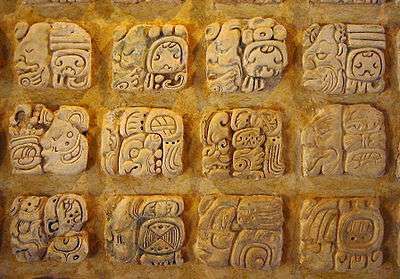Classic Maya language
| Classic Maya | |
|---|---|
|
Part of an inscription at Palenque | |
| Region | Yucatan, Guatemala |
| Era | 9th through 12th centuries |
|
Mayan
| |
| Language codes | |
| ISO 639-3 |
emy |
Linguist list |
emy Epigraphic Mayan |
| Glottolog |
epig1241 (Epigraphic Mayan)[1] |
Classic Maya is the oldest historically attested member of the Mayan language family. It is the main language documented in the pre-Columbian inscriptions of the Classic Era Maya civilization.
Relationships
It is now thought that the codices and other Classic texts were written by scribes, usually members of the Maya priesthood, in a literary form of the Ch’olti’ language.[2][3] It is possible that the Maya elite spoke this language as a lingua franca over the entire Maya-speaking area, but also that texts were written in other Mayan languages of the Petén and Yucatán, especially Yucatec. There is also some evidence that the Maya script may have been occasionally used to write Mayan languages of the Guatemalan Highlands.[3] However, if other languages were written, they may have been written by Ch’olti’ scribes, and therefore have Ch’olti’ elements.
Writing system
Classic Maya is the principal language documented in the writing system used by the pre-Columbian Maya, and is particularly represented in inscriptions from the lowland regions and the period c. 200—900. The writing system (generally known as the Maya script) has some similarities in function (but is not related to) other logosyllabic writing systems such as the cuneiform originating in Sumer, in which a combination of logographic and syllabic signs (graphemes) are used. The script's corpus of graphemes features a core of syllabic signs which reflect the phonology of the Classic Maya language spoken in the region and at that time, which were also combined or complemented by a larger number of logograms. Thus the expressions of Classic Maya could be written in a variety of ways, represented either as logograms, logograms with phonetic complements, logograms plus syllables, or in a purely syllabic combination. For example, in one common pattern many verb and noun roots are given by logographs, while their grammatical affixes were written syllabically, much like the Japanese writing system.
Grammar
Like most other Mayan languages, Classic Maya is verb–subject–object and is an ergative–absolutive language. Being polysynthetic, it uses both prefixes and suffixes to show grammatical function. Nouns are not inflected for case or gender. There is also an entire class of intransitives that convey the object's spatial position. In addition, the language employs counter words when quantifying nouns and uses a vigesimal number system. Verbs are not conjugated according to tense, but rather are semantically altered by a series of aspect particles.
References
- ↑ Hammarström, Harald; Forkel, Robert; Haspelmath, Martin; Bank, Sebastian, eds. (2016). "Epigraphic Mayan". Glottolog 2.7. Jena: Max Planck Institute for the Science of Human History.
- ↑ Houston, Stephen D.; Robertson, John; Stuart, David (2000). "The Language of Classic Maya Inscriptions". Current Anthropology. 41 (3): 321–356. doi:10.1086/300142. ISSN 0011-3204. PMID 10768879.
- 1 2 Kettunen and Helmke (2005, p.12)
- Aulie, H. Wilbur; Evelyn W. Aulie, eds. (1998) [1978]. Diccionario Ch'ol de Tumbalá, Chiapas, con variaciones dialectales de Tila y Sabanilla [Ch'ol Dictionary of Tumbalá, Chiapas with dialectal variations from Tila and Sabanilla]. Serie de vocabularios y diccionarios indígenas "Mariano Silva y Aceves", No. 121. Emily Stairs (electronic reproduction with March 2005 corrections, 2nd ed.). Coyoacán, D.F.: Instituto Lingüístico de Verano. ISBN 968-31-0291-3. OCLC 42692322.
- Boot, Erik (2002). "A Preliminary Classic Maya-English/English-Classic Maya Vocabulary of Hieroglyphic Readings" (PDF). Mesoweb Articles. Mesoweb. Retrieved 2007-07-06.
- Coe, Michael D. (1992). Breaking the Maya Code. London: Thames & Hudson. ISBN 0-500-05061-9.
- Hernández de León-Portilla, Ascención (2004). "Lenguas y escrituras mesoamericanas". Arqueología Mexicana (in Spanish). XII (70): 20–25. ISSN 0188-8218. Retrieved 2007-07-06.
- Houston, Stephen D. (1989). Reading the Past: Maya Glyphs. London: British Museum Publications. ISBN 0-7141-8069-6.
- Kettunen, Harri; Christophe Helmke (2005). Introduction to Maya Hieroglyphs (PDF). Wayeb and Leiden University. Retrieved 2007-07-06.
- Montgomery, John; Peter Mathews; Christophe Helmke (2002–2007). "Dictionary of Maya Hieroglyphs" (online version). Maya Hieroglyphic writing: Dictionaries. Foundation for the Advancement of Mesoamerican Studies, Inc (FAMSI). Retrieved 2007-07-06.
- Stuart, David (December 1987). "Ten Phonetic Syllables" (PDF). Research Reports on Ancient Maya Writing, 14 (online publication: October 2005 ed.). Washington, D.C.: Center for Maya Research. Retrieved 2007-07-06.
- Thompson, J. Eric S. (1971). Maya Hieroglyphic Writing; An Introduction. Civilization of the American Indian Series (No. 56) (3rd ed.). Norman: University of Oklahoma Press. ISBN 0-8061-0447-3.
